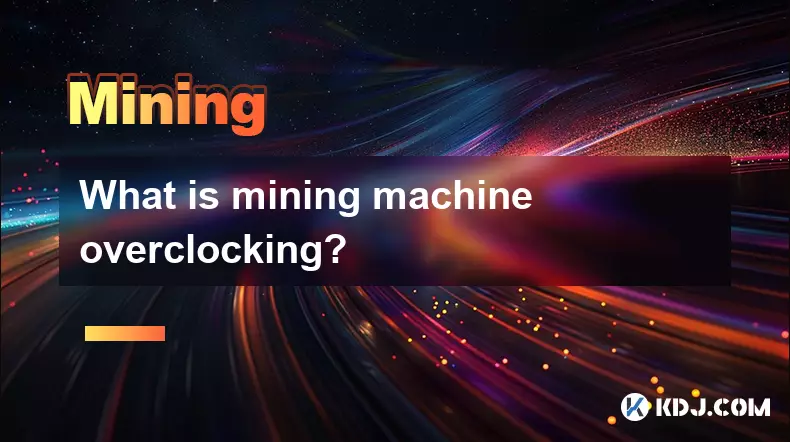-
 bitcoin
bitcoin $114779.865156 USD
2.30% -
 ethereum
ethereum $4226.519789 USD
2.39% -
 tether
tether $1.000545 USD
0.04% -
 xrp
xrp $2.890223 USD
0.92% -
 bnb
bnb $1030.029301 USD
2.95% -
 solana
solana $212.824944 USD
1.69% -
 usd-coin
usd-coin $0.999757 USD
0.01% -
 dogecoin
dogecoin $0.234961 USD
-0.27% -
 tron
tron $0.337174 USD
0.42% -
 cardano
cardano $0.804783 USD
0.09% -
 hyperliquid
hyperliquid $45.748770 USD
-2.85% -
 chainlink
chainlink $21.699170 USD
0.82% -
 ethena-usde
ethena-usde $1.001452 USD
0.08% -
 avalanche
avalanche $30.237800 USD
1.14% -
 stellar
stellar $0.372604 USD
1.52%
How much space do you need for a mining rig?
A standard 6-GPU mining rig measures about 18"x24"x8", requiring 24" clearance around it for airflow, with vertical setups saving up to 50% space.
Aug 09, 2025 at 07:29 pm

Understanding the Physical Dimensions of a Mining Rig
The amount of space required for a mining rig depends on several factors, including the number of GPUs, the type of frame or case used, and the need for airflow and cable management. A standard GPU mining rig with six graphics cards typically measures around 18 inches wide, 24 inches deep, and 8 inches tall when built on an open-air frame. These frames are often made of metal or acrylic and are designed for maximum ventilation. When placing such a rig, ensure you have at least 24 inches of clearance on all sides, especially behind and above, to allow proper airflow and reduce heat buildup. In confined spaces, overheating can severely impact performance and hardware lifespan.
Factors Influencing Space Requirements
The total footprint of a mining rig is influenced by multiple components beyond the frame itself. The power supply unit (PSU), which is often large and mounted externally or beneath the rig, adds to the spatial needs. A typical 1600W PSU can measure up to 7 inches by 6 inches by 3 inches. Additional equipment such as extension cords, riser cables, and power distribution units (PDUs) must also be accounted for. If you're using multiple rigs, stacking or arranging them side by side requires careful planning. Each rig should be spaced at least 12 inches apart to prevent thermal interference. Moreover, cooling fans or air conditioning units placed nearby also need dedicated space.
Indoor vs. Outdoor Mining Setups
For indoor mining, space constraints are more critical due to noise and heat output. A single rig can generate 800 to 1200 BTUs per hour, equivalent to a small space heater. This necessitates a well-ventilated room with active cooling. A dedicated mining closet or shed measuring at least 4 feet by 4 feet can house one to two rigs comfortably. For larger operations, a garage or basement with reinforced flooring and proper electrical circuits is ideal. In contrast, outdoor mining containers or shipping crates offer scalable solutions. These modified containers can accommodate 10 to 20 rigs and include built-in ventilation, security, and power distribution systems. However, they require a flat, stable surface and access to power and internet.
Calculating Total Space for Multiple Rigs
When planning for multiple mining rigs, use a systematic approach to determine spatial needs. Begin by measuring the dimensions of one rig including clearance. Then, calculate the total area based on the number of units. For example:
- One rig with clearance: 24' x 30' = 5 square feet
- Ten rigs in a single row: 50 square feet
- Add 20% extra space for maintenance access: 60 square feet totalUse a non-combustible surface such as concrete or metal flooring. Avoid carpeted or wooden areas due to fire risk. Position rigs so that air intake and exhaust are unobstructed. If using a rack system, ensure the rack allows vertical spacing of at least 6 inches between units. Cable trays mounted beneath or beside the rigs help organize SATA power connectors, PCIe risers, and data cables.
Optimizing Space with Vertical and Modular Setups
To save floor space, consider vertical mining frames that stack GPUs in a tower-like configuration. These can reduce the footprint by up to 50% compared to horizontal builds. Some modular systems allow hot-swapping of GPU trays, enabling compact, high-density arrangements. Another option is wall-mounted rigs, which use brackets to suspend the frame at chest height, freeing up floor area. However, wall mounting requires secure anchoring into studs and may complicate maintenance. For large-scale operations, data center-style racks with integrated cooling and power are available. These can support 12 to 16 GPUs per 42U rack, but require professional installation and climate control.Power and Network Infrastructure Considerations
Space planning must include room for electrical panels, surge protectors, and network switches. A single rig may draw 1000 to 1500 watts, requiring a dedicated 20-amp circuit. Use industrial-grade extension cords rated for continuous load, and avoid daisy-chaining power strips. Network connectivity is essential for monitoring and pool communication. Allocate space for a router or managed switch within 10 feet of the rigs to minimize Ethernet cable length. If using Wi-Fi, ensure strong signal coverage. For remote monitoring, install a low-power always-on device such as a Raspberry Pi, which can be mounted on the rig frame or placed on a nearby shelf.Frequently Asked Questions
Can I place a mining rig under a desk? Placing a mining rig under a desk is not recommended. Limited airflow leads to overheating, and noise levels (60–80 dB) can be disruptive. Desks often lack the structural support for heavy PSUs and may obstruct cable routing. If unavoidable, ensure the desk is metal, elevated, and has side vents. Use external cooling and monitor temperatures closely.How much headroom is needed above a mining rig?At least 18 inches of vertical clearance above the rig is necessary to allow hot air to escape. In rooms with low ceilings, rising heat can create a thermal layer that reduces cooling efficiency. Install an exhaust fan in the ceiling or wall to actively remove warm air.
Do mining rigs require special flooring?Yes. Rigs should be placed on non-flammable, static-resistant surfaces. Concrete, tile, or metal flooring is ideal. Avoid wood, carpet, or vinyl, which can retain heat and pose fire hazards. Use an anti-static mat if operating in a dry environment to prevent electrostatic discharge.
Is it safe to stack mining rigs on top of each other?Stacking rigs is unsafe without proper design. Heat from the lower unit can damage the one above. Only use manufacturer-approved stacking kits with built-in insulation and airflow channels. Even then, monitor both units for temperature spikes and reduce overclocking settings to minimize thermal output.
Disclaimer:info@kdj.com
The information provided is not trading advice. kdj.com does not assume any responsibility for any investments made based on the information provided in this article. Cryptocurrencies are highly volatile and it is highly recommended that you invest with caution after thorough research!
If you believe that the content used on this website infringes your copyright, please contact us immediately (info@kdj.com) and we will delete it promptly.
- ChatGPT, Bitcoin, and $HYPER: Riding the Crypto Wave
- 2025-09-30 16:25:14
- Mutuum Finance (MUTM): Riding the DeFi Wave with Crypto Price Prediction
- 2025-09-30 16:25:14
- XRP ETF Approval Odds Soar: Analyst Predicts $33 Price Surge!
- 2025-09-30 16:30:01
- Keel, Solana, and Sky Stablecoin: Fueling the Future of DeFi
- 2025-09-30 16:45:13
- EcoChain, DePIN Infrastructure, and X1Nodes: Powering the Web4 Revolution
- 2025-09-30 16:30:01
- Pi Network's Institutional Momentum: Leading the Web3 Revolution
- 2025-09-30 16:45:13
Related knowledge

The difference between staking and mining
Sep 24,2025 at 05:18am
Understanding Staking in the Cryptocurrency Ecosystem1. Staking involves holding funds in a cryptocurrency wallet to support the operations of a block...

How to participate in testnet mining?
Sep 22,2025 at 09:18am
Understanding Testnet Mining in the Crypto Ecosystem1. Testnet mining is a method used by blockchain developers to simulate real-world conditions on a...

How to dispose of abandoned mining machines?
Sep 19,2025 at 08:19pm
Assessing the Condition of Abandoned Mining Rigs1. Begin by inspecting each mining machine for visible damage, corrosion, or missing components. Machi...

How to identify high-quality mining pools?
Sep 21,2025 at 03:19pm
Reputation and Track Record1. A mining pool’s reputation is built over time through consistent performance and transparency. Pools that have operated ...

Advantages of decentralized mining pools
Sep 20,2025 at 04:36pm
Enhanced Security and Resistance to Censorship1. Decentralized mining pools operate on blockchain-based smart contracts, eliminating the need for a ce...

What is mining machine overclocking?
Sep 21,2025 at 07:19pm
Understanding Mining Machine Overclocking1. Mining machine overclocking refers to the process of increasing the operating frequency of a cryptocurrenc...

The difference between staking and mining
Sep 24,2025 at 05:18am
Understanding Staking in the Cryptocurrency Ecosystem1. Staking involves holding funds in a cryptocurrency wallet to support the operations of a block...

How to participate in testnet mining?
Sep 22,2025 at 09:18am
Understanding Testnet Mining in the Crypto Ecosystem1. Testnet mining is a method used by blockchain developers to simulate real-world conditions on a...

How to dispose of abandoned mining machines?
Sep 19,2025 at 08:19pm
Assessing the Condition of Abandoned Mining Rigs1. Begin by inspecting each mining machine for visible damage, corrosion, or missing components. Machi...

How to identify high-quality mining pools?
Sep 21,2025 at 03:19pm
Reputation and Track Record1. A mining pool’s reputation is built over time through consistent performance and transparency. Pools that have operated ...

Advantages of decentralized mining pools
Sep 20,2025 at 04:36pm
Enhanced Security and Resistance to Censorship1. Decentralized mining pools operate on blockchain-based smart contracts, eliminating the need for a ce...

What is mining machine overclocking?
Sep 21,2025 at 07:19pm
Understanding Mining Machine Overclocking1. Mining machine overclocking refers to the process of increasing the operating frequency of a cryptocurrenc...
See all articles










































































